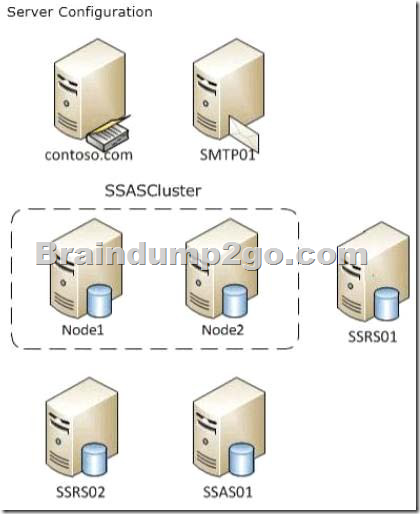2015 Latest 70-467 Real exam questions to master and practice upon! Braindump2go Offers the New Updated Microsoft 70-467 189 Exam Questions in PDF & VCE files that can also be downloaded on every mobile device for preparation!
Vendor: Microsoft
Exam Code: 70-467
Exam Name: Designing Business Intelligence Solutions with Microsoft SQL Server 2012 Exam
QUESTION 51
You need to define the trend calculation for the sales performance KPI.
Which KPI trend MDX expression should you use?
A. CASE
WHEN [Sales Variance %] < ([Sales Variance %], [Date].[Calendar].PrevMember)
THEN-1 WHEN [Sales Variance %] =
([Sales Variance %], [Date].[Calendar].PrevMember) THEN 0 ELSE 1 END
B. IIF([Sales Variance %3 < ([Sales Variance %], [Date].[Calendar].PrevMember), 1, 0)
C. IIF([Sales Variance %] < ([Sales Variance %], [Date].[Calendar].PrevMember), 0, 1)
D. CASE
WHEN [Sales Variance %] < ([Sales Variance %], [Date].[Calendar].PrevMember)
THEN 1 WHEN [Sales Variance %] =
([Sales Variance %], [Date].[Calendar].PrevMember) THEN 0 ELSE-1 END
Answer: A
QUESTION 52
Drag and Drop Questions
You need to extend the schema design to store the product dimension data.
Which design should you use? To answer, drag the appropriate table or tables to the correct location or locations in the answer area. (Fill from left to right. Answer choices may be used once, more than once, or not all.)
Answer:
Explanation:
– From scenario:
– The schema design must be extended to include the product dimension data.
– DimProduct table need to contain a foreign key to the DimSubCategory table.
No further SubCategory data should be stored in the DimProduct table.
– No time related columns (StartDate, EndDate) should be included in the DimProduct table.
QUESTION 53
You need to configure package execution logging to meet the requirements.
What should you do?
A. Configure logging in each ETL package to log the OnError, Onlnformation, and
Diagnostic events.
B. Set the SSIS catalog’s Server-wide Default Logging Level property to Performance.
C. Set the SSIS catalog’s Server-wide Default Logging Level property to Basic.
D. Set the SSIS catalog’s Server-wide Default Logging Level property to Verbose.
E. Configure logging in each ETL package to log the OnError, OnPreExecute, and
OnPostExecute events.
Answer: B
QUESTION 54
You need to create the Sales Reporting shared SSRS data source.
Which SSRS data connection type should you use?
A. OData
B. Microsoft SQL Server
C. ODBC
D. OLE DB
Answer: B
QUESTION 55
You need to select an appropriate tool for creating the Regional Sales report.
Which tool or tools should you use? (Each correct answer presents a complete solution.
Choose all that apply.)
A. Excel 2010, using the CUBE functions
B. Power View, using a Matrix
C. Excel 2010, using a PivotTable
D. Report Builder, using a Matrix
Answer: BCD
Explanation:
B: Working with a matrix in Power View
A matrix is a type of visualization that is similar to a table in that it is made up of rows and columns. However, a matrix can be collapsed and expanded by rows and/or columns. If it contains a hierarchy, you can drill down/drill up.
C: Using an Excel Pivot Table, connecting to the Cube, will give you the option to drill the down cube. Using conditional formatting you can highlight specific value ranges.
D: Matrices provide functionality similar to crosstabs and pivot tables. At run time, as the report data and data regions are combined, a matrix grows horizontally and vertically on the page. Values in matrix cells display aggregate values scoped to the intersection of the row and column groups to which the cell belongs. You can format the rows and columns to highlight the data you want to emphasize. You can also include drilldown toggles that initially hide detail data; the user can then click the toggles to display more or less detail as needed.
– From scenario:
Management has requested a new report named Regional Sales. This report must be based on the Sales cube and must allow users to filter by a specific year and present a grid with every region on the columns and the Products hierarchy on the rows. The hierarchy must initially be collapsed and allow the user to drill down through the hierarchy to analyze sales. Additionally, sales values that are less than S5000 must be highlighted in red.
QUESTION 56
You need to select an appropriate tool for creating the Regional Sales report.
Which tools or tools should you use? (Each Answer presents a complete solution. Choose all that apply.)
A. Power View, using a table configured for vertical multiples
B. Excel 2010, using a PivotTable
C. Report Builder, using a Matrix
D. Power View, using a table configured for horizontal multiples
Answer: BC
QUESTION 57
You need to create the calculation for SalespersonName.
What should you do? (Each Answer presents a complete solution. Choose all that apply.)
A. Create a computed column in the data warehouse’s DimSalesperson table.
Include the column in the Sales Reporting model’s Salesperson table.
B. Modify the data warehouse’s DimSalesperson table and add a new column.
Use an UPDATE statement to populate the new column with values.
Update the SSIS package developed to populate the data warehouse’s DimSalesperson
table to use a Derived Column transformation to produce the calculation.
C. Configure the Sales Reporting model’s Salesperson table properties to be based on a query.
Define a derived column in the query.
D. Add a calculated column to the Sales Reporting model’s Salesperson table by using the Data
Analysis Expressions (DAX) language CONCATENATE function.
E. Create a view in the data warehouse that defines a derived column based on the
DimSalesperson table. Base the Sales Reporting model’s Salesperson table on the view.
Include the column in the Sales Reporting model’s Salesperson table.
F. Add a calculated column to the Sales Reporting model’s Salesperson table by using the Data
Analysis Expressions (DAX) language ADDCOLUMNS function.
Answer: BE
QUESTION 58
You need to configure data refresh for the Manufacturing Performance PowerPivot workbook.
What should you do? (Each Answer presents part of the solution. Choose ail that apply.)
A. Configure the PowerPivot Data Refresh Timer Job to run every 60 minutes.
B. Restore the PowerPivot workbook to an SSAS instance in tabular mode.
C. Script a process command and configure a SQL Server Agent job to execute the command
every 60 minutes.
D. Restore the PowerPivot workbook to an SSAS instance in PowerPivot for SharePoint mode.
Answer: A
QUESTION 59
You need to complete the following UPDATE statement to initialize the budget sales values for 2012.
Which MDX weight value expression should you use? To answer, drag the appropriate weight value expression to the answer area.
Answer:
Case Study: 2 – Contoso, Ltd (QUESTION 60 – QUESTION 72)
General Background
You are the SQL Server Administrator for Contoso, Ltd.
You have been tasked with upgrading all existing SQL Server instances to SQL Server 2012.
Technical Background
The corporate environment includes an Active Directory Domain Services (AD DS) domain named contoso.com. The forest and domain levels are set to Windows Server 2008. All default containers are used for computer and user accounts. All servers run Windows Server 2008 R2 Service Pack 1 (SP1). All client computers run Windows 7 Professional SP1. All servers and client computers are members of the contoso.com domain. The current SQL Server environment consists of a single instance failover cluster of SQL Server 2008 R2 Analysis Services (SSAS). The virtual server name of the cluster is SSASCluster. The cluster includes two nodes: Node1 and Node2. Node1 is currently the active node. In anticipation of the upgrade, the prerequisites and shared components have been upgraded on both nodes of the cluster, and each node was rebooted during a weekly maintenance window. A single-server deployment of SQL Server 2008 R2 Reporting Services (SSRS) in native mode is installed on a server named SSRS01. The Reporting Server service is configured to use a domain service account. SSRS01 hosts reports that access the SSAS databases for sales data as well as modeling data for the Research team. SSRS01 contains 94 reports used by the organization. These reports are generated continually during business hours. Users report that report subscriptions on SSRS01 are not being delivered. You run the reports on demand from Report Manager and find that the reports render as expected. A new server named SSRS02 has been joined to the domain, SSRS02 will host a single-server deployment of SSRS so that snapshots of critical reports are accessible during the upgrade. The server configuration is shown in the exhibit. (Click the Exhibit button.)
The production system includes three SSAS databases that are described in the following table.
All SSAS databases are backed up once a day, and backups are stored offsite.
Business Requirements
After the upgrade users must be able to perform the following tasks:
– Ad-hoc analysis of data in the SSAS databases by using the Microsoft Excel PivotTable client.
– Daily operational analysis by executing a custom application that uses ADOMD.NET and existing Multidimensional Expressions (MDX) queries.
The detailed data must be stored in the model.
Technical Requirements
You need to minimize downtime during the SSASCIuster upgrade.
The upgrade must minimize user intervention and administrative effort. The upgrade to SQL Server 2012 must maximize the use of all existing servers, require the least amount of administrative effort, and ensure that the SSAS databases are operational as soon as possible. You must implement the highest level of domain security for client computers connecting to SSRS01. The SSRS instance on SSRS01 must use Kerberos delegation to connect to the SSAS databases. Email notification for SSRS01 has not been previously configured. Email notification must be configured to use the SMTP server SMTP01 with a From address of [email protected]. Report distribution must be secured by using SSL and must be limited to the contoso.com domain.
You have the following requirements for SSRS02:
– Replicate the SSRS01 configuration.
– Ensure that all current reports are available on SSRS02.
– Minimize the performance impact on SSR501.
In preparation for the upgrade, the SSRS-related components have been installed on the new SSRS02 server by using the Reporting Services file-only installation mode. The Reporting Services databases have been restored from SSRS01 and configured appropriately.
You must design a strategy to recover the SSRS instance on SSRS01 in the event of a system failure. The strategy must ensure that SSRS can be recovered in the minimal amount of time and that reports are available as soon as possible. Only functional components must be recovered. SSRS02 is the recovery server and is running the same version of SSRS as SSRS01.
A full backup of the SSRS databases on SSRS01 is performed nightly. The report server configuration files, custom assemblies, and extensions on SSRS02 are manually synchronized with SSRS01. Prior to implementing the upgrade to SQL Server 2012, you must back up all existing SSAS databases. Databases on SSRS01 is performed nightly. The report server configuration files, custom assemblies, and extensions on SSRS02 are manually synchronized with SSRS01.
Prior to implementing the upgrade to SQL Server 2012, you must back up all existing SSAS databases. The backup must include only the partitioning, metadata, and aggregations to minimize the processing time required when restoring the databases.
You must minimize processing time and the amount of disk space used by the backups. Before upgrading SSAS on the SSASCluster, all existing databases must be moved to a temporary staging server named SSAS01 that hosts a default instance of SQL Server 2012 Analysis Services. This server will be used for testing client applications connecting to SSAS 2012, and as a disaster recovery platform during the upgrade. You must move the databases by using the least amount of administrative effort and minimize downtime. All SSAS databases other than the Research database must be converted to tabular BI Semantic Models (BISMs) as part of the upgrade to SSAS 2012. The Research team must have access to the Research database for modeling throughout the upgrade. To facilitate this, you detach the Research database and attach it to SSAS01. While testing the Research database on SSAS01, you increase the compatibility level to 1100.
You then discover a compatibility issue with the application.
You must roll back the compatibility level of the database to 1050 and retest.
After completing the upgrade, you must do the following:
1. Design a role and assign an MDX expression to the Allowed member set property of the Customer dimension to allow sales representatives to browse only members of the Customer dimension that are located in their sales regions. Use the sales representatives’ logins and minimize impact on performance.
2. Deploy a data model to allow the ad-hoc analysis of data. The data model must be cached and source data from an OData feed.
QUESTION 60
You need to configure security for the SSRS instance on SSRS01 to connect to SSAS and minimize downtime.
What should you do? (Each correct answer presents part of the solution. Choose all that apply.)
A. Register a service principal name for the Report Server service.
B. Register a service principal name for the Analysis Services service.
C. Restart the IIS service.
D. Configure SSRS01 to use the Negotiate authentication type.
E. Configure SSRS01 to use the Custom authentication type.
Answer: AD
Explanation:
A (not B): If you are deploying Reporting Services in a network that uses the Kerberos protocol for mutual authentication, you must create a Service Principal Name (SPN) for the Report Server service if you configure it to run as a domain user account.
D (not E):
– See step 6 below.
To register an SPN for a Report Server service running as a domain user
– Install Reporting Services and configure the Report Server service to run as a domain user account. Note that users will not be able to connect to the report server until you complete the following steps.
– Log on to the domain controller as domain administrator.
– Open a Command Prompt window.
– Copy the following command, replacing placeholder values with actual values that are valid for your network:
– Setspn-a http/<computer-name>.<domain-name>:<port> <domain-user-account>
– Run the command.
– Open the RsReportServer.config file and locate the <AuthenticationTypes> section. Add <RSWindowsNegotiate/> as the first entry in this section to enable NTLM.
– RSWindowsNegotiate. If you initially set the Windows service account for the report server to NetworkService or LocalSystem in Reporting Services Configuration Manager, RSWindowsNegotiate is added to the RSReportServer.config file as the default setting. With this setting, the report server can accept requests from client applications requesting Kerberos or NTLM authentication. If Kerberos is requested and the authentication fails, the report server switches to NTLM authentication and prompts the user for credentials unless the network is configured to manage authentication transparently.
Using RSWindowsNegotiate is your best option because it provides the greatest flexibility for multiple clients in an intranet environment.
Not C: IIS is not mention in this scenario.
Note:
– From scenario:
– A single-server deployment of SQL Server 2008 R2 Reporting Services (SSRS) in native mode is installed on a server named SSRS01. The Reporting Server service is configured to use a domain service account.
Reference: Register a Service Principal Name (SPN) for a Report Server
Braindump2go New Released 70-467 Dump PDF Free Download, 189 Questions in all, Passing Your Exam 100% Easily! 

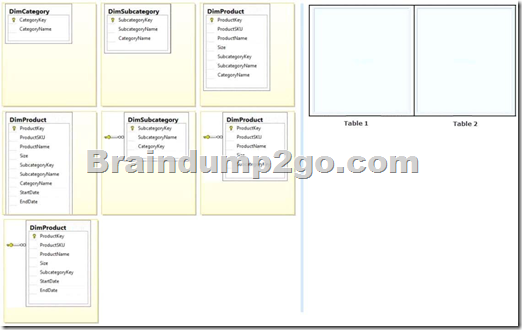
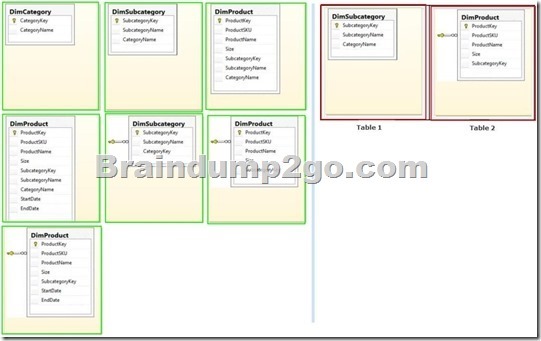
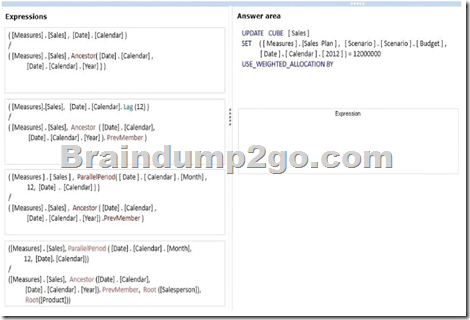
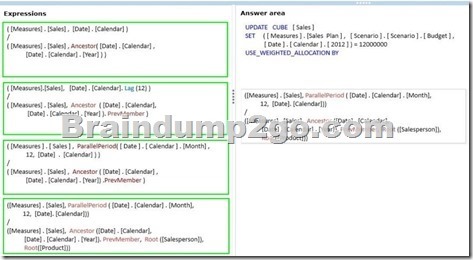
![wps7255.tmp_thumb[2] wps7255.tmp_thumb[2]](http://examgod.com/bdimages/9e18d0bb997b_A990/wps7255.tmp_thumb2_thumb.png)
